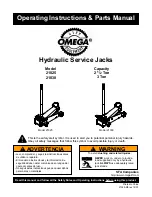
V1.0
2 PC RV Scissor Jacks
8516684
Visit www.princessauto.com for more information
5
IDENTIFICATION KEY
A
Bracket
B
Upper Arm
C
Lower Arm
D
Handle Receiver
E
Base
F
Crank Handle
ASSEMBLY & INSTALLATION
Letter references in parenthesis (A) refer to the included Identification Key.
The RV scissor jacks must be mounted in the correct location to avoid damage
when travelling in the retracted position. Once the proper position is
determined, the scissor jack can be mounted to the trailer’s chassis with bolts
or by welding it in place.
There must be 20 in. or less clearance between the ground and the chassis.
1.
Park the trailer on a level surface capable of sustaining the load. Chock all
wheels to prevent the trailer from rolling.
2. Disconnect your towing vehicle and move it away.
3.
Level the trailer. Place jack stands or your existing trailer jacks under the
trailer to support it while installing the stabilization jacks.
4.
Tie a string to the bottom of the rear bumper or overhang, pull it taut,
then tuck the tag end under the rearmost wheel. This creates a visual
border to help position the jack.
a.
Tie the string to the trailer hitch receiver and tuck the tag end under
the front of the foremost wheel when installing the front scissor
jacks.
5.
The scissor jack must be connected to a solid part of the frame such as a
rail. The connection point must also be large enough for the bracket.
6. Hold the retracted jack against the chassis’ rail or connection point with
the trailer handle receiver (D) facing outward. Position the jack so no part
extends past the string. The handle receiver must not extend past the
trailer’s side.
a.
Positioning the jack within the string ensures the rear bumper will
strike the ground first when traveling on a steep incline or
encountering a speed bump.






































